=+37.17. 1 Show that p(s, t) = p(t-1, s-1) = p(cs, ct). Check this by (37.47) and
Question:
=+37.17. 1 Show that p(s, t) = p(t-1, s-1) = p(cs, ct). Check this by (37.47) and also by the fact that the transformations (37.11) and (37.12) preserve the properties of Brownian motion.
Fantastic news! We've Found the answer you've been seeking!
Step by Step Answer:
Related Book For 

Probability And Measure Wiley Series In Probability And Mathematical Statistics
ISBN: 9788126517718
3rd Edition
Authors: Patrick Billingsley
Question Posted:






